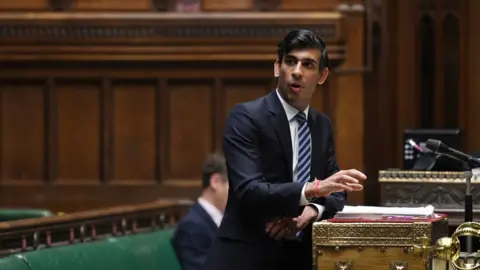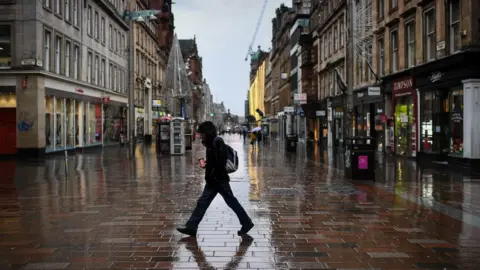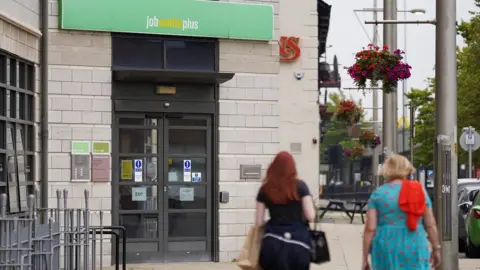Spending review: As aftershocks go on
 PA Media
PA Media- The tax bit of the budget is missing from the one-year spending review from Rishi Sunak, which has to prepare for continued aftershocks from the pandemic earthquake into the next financial year
- Much has been signalled or announced by Downing Street, including defence, a big green plan and infrastructure for the north of England
- The Scottish government wants to keep spending. It should find out next year's block grant, and the challenge of whether to adopt a public sector pay freeze
Rishi Sunak addresses the sparsely populated, socially-distanced green benches of the House of Commons today with a spending review. It is half a budget, with the tax bit missing.
And until we see that, some time before the end of March, a lot of the chancellor's plans and projections for the economy remain sketchy.
He's still in crisis mode, with tax revenue down and spending continuing to soar, funded by epic amounts of borrowing. He tried to nail down the furniture earlier in this seismic shaking of the economy's foundations, but the pandemic made a fool of such optimism.
 Getty Images
Getty ImagesA second, autumnal lockdown has not been as harsh for the economy as the first, but it has added considerably to the bills and to the lost revenue from hoped-for recovery.
There may be more to follow. There may also be a blow to the economy from a no-deal Brexit.
Alongside Mr Sunak's spending review, the Office for Budget Responsibility will set out its estimates of the spending commitments so far, the size of the deficit this year, and of future growth. Expect them to feature those "fan diagrams" in which economists' range of possible outcomes vary widely.
Levelling up
No budget has come close to the level of borrowing required to pay the costs of Covid so far. Nor have we seen a peace-time fall in output like this one, expected to be down more than 10% this year for both the UK and Scotland.
And the missing tax part of the budget means the decision on when to turn the corner on the spending splurge and start tackling the deficit is being delayed. It will have to happen, and how it happens will be difficult, but there's widespread agreement on "not yet".
Elements of this spending review have been either signalled or announced. Defence spending is to go up a lot, and that promise continues over several years.
We're yet to find out if that is at a cost to other spending departments, including those who contribute to the Barnett Formula for devolved administrations - the Ministry of Defence does not.
That was trailed in the context of jobs. And for Scottish shipyards, the prime minister's emphasis on the Royal Navy should sound good. But building complex warships for the Navy is no longer to be focused on the Clyde alone. The intention is to spread the economic benefit around, levelling up Merseyside, Tyneside, Belfast and Devon.
The prime minister also set out big plans for tackling climate change, some of which might feed through to this year's spending review.
There is to be a lot of infrastructure spending, shifting the Treasury's bias from the south of England, in an economic and political project to "level up" the north of England.
If that is only a rebalancing of spend within England, then it's clear that levelling up is not about parts of Scotland, Wales or Northern Ireland that feel left behind.
Conflicts and contortions
What most matters in the spending review to Scotland, as well as Wales and Northern Ireland, is the size of the block grant from the start of April. Despite significant tax devolution, it remains key to planning in St Andrew's House, where finance secretary Kate Forbes has until 28 January to prepare her draft budget.
That could vary widely. It could bake in some of the uplift in spending over the past year, or it could pare it back, close to the budget Holyrood thought it would have for the current year when it passed it on 11 March.
It is not known, but possible, that spending could have two budgets - a baseline one, if the pandemic crisis for public services, welfare spend and for the economy is easing by early in 2021-22, and on top of that, a reserve for continued aftershocks. If so, Holyrood would have to contend with the same ambiguity.
Also signalled ahead of the review is a freeze to public sector pay. That may not apply to politically-sensitive health and care roles. But in the past, such a constraint has put a similar constraint on the Scottish government. SNP MPs are already complaining that this is no time to freeze pay, but it may turn out to be a Holyrood policy they have to defend.
 Getty Images
Getty ImagesConservatives are conflicted over whether to retain the pandemic uplift to Universal Credit, of £20 per week. With so much largesse floating around, and much of it reaching cronies flogging PPE, the politics of a cut don't look easy.
Similar contortions will be required if Rishi Sunak pulls back on the legally-binding commitment to spend 0.7% of total economic output on overseas aid. Former Scottish Tory leader Ruth Davidson has joined former Tory prime ministers by warning firmly against it.
There is room for fudge there. Overseas development has been folded into the Foreign Office in Whitehall, and even before that, "aid" was already being flexibly defined.
Inbound "aid" is also at issue, with clarity expected - or hoped for - on the replacement for European structural funds. With little more than a month until the economic bit of Brexit begins to bite, watch out for a decision on the UK Shared Prosperity Fund, and whether sharing means control at Westminster or being devolved.
There is plenty of politics in this economic set-piece, and plenty more politics to come when the tax bills come in.
